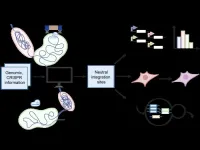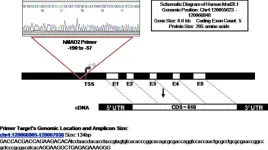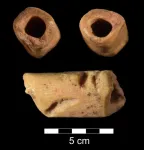CRISPR-copies: New tool accelerates and optimizes genome editing
CABBI researchers publically share a new tool to revolutionize CRISPR gene editing
2024-02-13
(Press-News.org) CRISPR/Cas systems have undergone tremendous advancement in the past decade. These precise genome editing tools have applications ranging from transgenic crop development to gene therapy and beyond. And with their recent development of CRISPR-COPIES, researchers at the Center for Advanced Bioenergy and Bioproducts Innovation (CABBI) are further improving CRISPR’s versatility and ease of use.
“CRISPR-COPIES is a tool that can quickly identify appropriate chromosomal integration sites for genetic engineering in any organism,” said Huimin Zhao, CABBI Conversion Theme Leader and Steven L. Miller Chair of Chemical and Biomolecular Engineering (ChBE) at the University of Illinois. “It will accelerate our work in the metabolic engineering of non-model yeasts for cost-effective production of chemicals and biofuels.”
Gene editing has revolutionized scientists’ capabilities in understanding and manipulating genetic information. This form of genetic engineering allows researchers to introduce new traits into an organism, such as resistance to pests or the ability to produce a valuable biochemical.
With CRISPR/Cas systems, researchers can make precise, targeted genetic edits. However, locating optimal integration sites in the genome for these edits has been a critical and largely unsolved problem. Historically, when researchers needed to determine where to target their edits, they would typically manually screen for potential integration sites, then test the site by integrating a reporter gene to assess its cellular fitness and gene expression levels. It’s a time- and resource-intensive process.
To address this challenge, the CABBI team developed CRISPR-COPIES, a COmputational Pipeline for the Identification of CRISPR/Cas-facilitated intEgration Sites. This tool can identify genome-wide neutral integration sites for most bacterial and fungal genomes within two to three minutes.
“Finding the integration site in the genome manually is like searching for a needle in a haystack,” said Aashutosh Boob, a ChBE Ph.D. student at the University of Illinois and primary author of the study. “However, with CRISPR-COPIES, we transform the haystack into a searchable space, empowering researchers to efficiently locate all the needles that align with their specific criteria.”
In their paper published in Nucleic Acids Research, the researchers demonstrated the versatility and scalability of CRISPR-COPIES by characterizing integration sites in three diverse species: Cupriavidus necator, Saccharomyces cerevisiae, and HEK 293T cells. They used integration sites found by CRISPR-COPIES to engineer cells with increased production of 5-aminolevulinic acid, a valuable biochemical that has applications in agriculture and the food industry.
In addition, the team has created a user-friendly web interface for CRISPR-COPIES. This incredibly accessible application can be used by researchers even without significant bioinformatics expertise.
A primary objective of CABBI is the engineering of non-model yeasts to produce chemicals and fuels from plant biomass. Economically producing biofuels and bioproducts from low-cost feedstocks at a large scale is a challenge, however, due to the lack of genetic tools and the cumbersome nature of traditional genome-editing methods. By enabling researchers to swiftly pinpoint genomic loci for targeted gene integration, CRISPR-COPIES provides a streamlined pipeline that facilitates the identification of stable integration sites across the genome. It also eliminates the manual labor involved in designing components for CRISPR/Cas-mediated DNA integration.
For crop engineering, the tool can be used to increase biomass yields, pest resistance, and/or environmental resilience. For converting biomass to valuable chemicals — for instance, by using the yeast S. cerevisiae — CRISPR-COPIES can be used to engineer cells with significantly greater yields.
This versatile software is designed to simplify and accelerate the strain construction process, saving researchers both time and resources. Researchers around the world in both academia and industry can benefit from its utility in strain engineering for biochemical production and transgenic crop development.
Co-authors on this study include ChBE Ph.D. student Zhixin Zhu, ChBE visiting student Pattarawan Intasian, and Bioengineering Ph.D. student Guanhua Xun; Carl R. Woese Institute for Genomic Biology (IGB) Software Developers Manan Jain and Vassily Petrov; IGB Biofoundry Manager Stephan Lane; and CABBI postdoc Shih-I Tan.
— Article by CABBI Communications Specialist April Wendling
END
[Attachments] See images for this press release:

ELSE PRESS RELEASES FROM THIS DATE:
2024-02-13
Nearly half of teenagers are worried about having children and many lack knowledge about their reproductive health, find two new studies by UCL researchers.
The studies, published in Human Fertility and Health Education Journal, used survey results from 931 students in England aged 16 to 18, collected between May 2021 and July 2022.
The Human Fertility paper found that a majority of students (64%) still wanted to have children in the future – with nearly half (49%) desiring to have two children.
However, 45% of all participants said that they had concerns about future ...
2024-02-13
The use of a digital remote monitoring technology in care homes has been found to reduce hospital A&E attendances by 11% and emergency admissions by 25% in a new study from the Health Data Research UK (HDR UK) Better Care programme, published today in Age and Ageing - the official journal of the British Geriatrics Society.
There are over 400,000 people living in care homes across the UK, many of whom will be living with complex medical needs that put them at greater risk of needing emergency healthcare, especially during the winter months.
Through the HDR UK Better Care programme, a collaboration between the universities ...
2024-02-13
New research on rural New Englanders shows that gardening, hunting, fishing and other HWFP activities are important tools for maintaining food security through extreme events, such as pandemics or climate change events.
University of Vermont and University of Maine researchers found that both food insecurity and home and wild food production (HWFP) – gardening, hunting, fishing, foraging, and having “backyard” poultry or livestock – increased significantly during the COVID-19 pandemic, and those who undertook HWFP activities exhibited improved food security 9-12 months later.
The paper, published in Scientific Reports, surveyed ...
2024-02-13
UNDER EMBARGO UNTIL: Feb. 12, 2024 5:45 p.m. Eastern Standard Time
Media Contacts: Karen Addis, APR, karen@addispr.com, +1 (301) 787-2394; Kerri Wade, MPA, kwade@smfm.org, +1 ...
2024-02-12
“[...] people of the northeastern region [of India] consume betel quid, consisting of raw areca nut [...]. People often swallow the entire betel-quid after chewing, which is believed to contribute to the development of oral, esophageal, and gastric cancers.”
BUFFALO, NY- February 12, 2024 – A new research paper was published in Oncotarget's Volume 15 on February 5, 2024, entitled, “Differential expression of Mad2 gene is consequential to the patterns of histone H3 post-translational modifications in its promoter region in human esophageal ...
2024-02-12
Rochester Institute of Technology’s Center for Detectors has been chosen by NASA for two research programs: Early Stage Innovations (ESI) and Strategic Astrophysics Technology (SAT), with the hope of helping future spacecraft find new discoveries in the vast universe.
Under the leadership of Center for Detectors Director Don Figer, the team will be advancing and characterizing single-photon sensing complementary metal-oxide semiconductor (CMOS) image sensors to determine if they can survive the harsh radiation environments in NASA missions. The intent is to fly these types of detectors on future missions to find life on Jupiter’s ...
2024-02-12
University of Wyoming archaeology Professor Todd Surovell and his team of collaborators have discovered a tube-shaped bead made of bone that is about 12,940 years old.
The bead, found at the La Prele Mammoth site in Converse County, is the oldest known bead in the Americas.
Surovell’s research was published in the peer-reviewed journal Scientific Reports; the paper is titled “Use of hare bone for the manufacture of a Clovis bead.” Members of the research team included people from UW, the Office of the Wyoming State Archaeologist, the University of Manchester, Weber ...
2024-02-12
BIRMINGHAM, Ala. – Multiple system atrophy is a rare and fatal neurodegenerative disease, where insoluble inclusions of the protein alpha-synuclein appear in oligodendrocyte cells of the brain. The resulting pathogenesis features neuroinflammation, demyelination and neurodegeneration. Oligodendrocytes produce myelin, an insulating sheath on the axons of nerves.
In 2020, Ashley Harms, Ph.D., and University of Alabama at Birmingham colleagues published an Acta Neuropathologica study that used a mouse model to show that the ...
2024-02-12
UNIVERSITY PARK, Pa. — Pumpkin toadlets are in trouble. Progressively severe droughts are disrupting the microbiomes of the thumbnail-sized orange frogs, potentially leaving them vulnerable to a deadly fungal disease, according to a new study by an international research team. The finding suggests that abnormal rainfall patterns, which are expected to worsen due to climate change and deforestation, may upset mutually beneficial relationships between wildlife and microorganisms, leading to biodiversity decline.
The researchers, led by Penn State doctoral ...
2024-02-12
UNDER EMBARGO UNTIL: Feb. 12, 2024, 4:30 PM EST
Media Contacts: Karen Addis, APR, karen@addispr.com, +1 (301) 787-2394; Kerri Wade, MPA, kwade@smfm.org, +1 (202) 236-1780
National ...
LAST 30 PRESS RELEASES:
[Press-News.org] CRISPR-copies: New tool accelerates and optimizes genome editing
CABBI researchers publically share a new tool to revolutionize CRISPR gene editing




